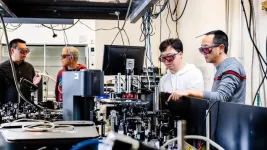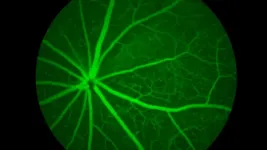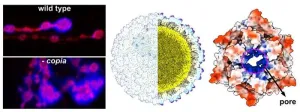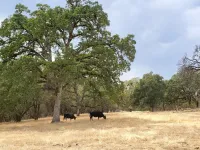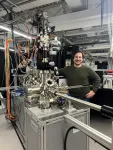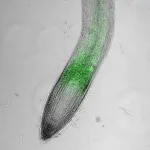(Press-News.org) UNIVERSITY PARK , Pa. — Urban versus rural. Penn State versus Michigan. Star Wars versus Star Trek. As social beings, humans gravitate toward groups. But sometimes group living can spur an “us versus them” mentality that causes conflict, especially when two groups are competing for the same limited resources, like money or a championship trophy.
In the following Q&A, Anne Pisor, assistant professor of anthropology at Penn State and Social Science Research Institute co-funded faculty member, discussed her recently published paper on the “us versus them” mindset as well as the causes and how to overcome it.
Q: What does your research say about the “us versus them” mindset? Is it real or a myth?
Pisor: It's not a myth, but it's not universal either. What really matters is whether we think there's something worth competing over. Humans are a hypersocial species, meaning we spend lots of time with other people. We're also a group living species, which means that we spend lots of time with the same “other” people, like our families, neighbors, teams at work, and members of religious and ethnic groups. Groups are important to us, and our brains are quick to recognize groups.
Sometimes groups can trigger an “us versus them” mindset. At work, you’re part of a team, cooperating to get projects and tasks done right. Sometimes it's challenging to get all the cooperation to work, but when it does, it feels really good. Now imagine there's another team that's working on a project like yours, and there's something that both teams want, but only one team can have, like a promotion or a particular customer. Suddenly, you're paying attention to who's on which team. That's when the “us versus them” mindset really gets activated.
Q: What role does perception play in activating the “us versus them” mindset?
Pisor: Initially, we have to recognize that there's a group in the first place. If you see someone walking down the street today, you may see them as just another person, but it's only if they're wearing maize and blue do you realize they might be a Michigan fan.
Next, there's the question of what you know about that other group. It may be that you've heard something about the Wolverines, or maybe you've interacted with Michigan fans in the past. Or maybe the person walking down the street is with three other fans wearing the same jerseys, and you're alone in your Penn State jersey — and then, regardless of what you've heard, you're outnumbered and feeling a bit wary.
Deciding whether another group is a threat depends on factors like group size, past experiences with that group, what other people have told you about the group and whether there's something both groups want but only one can have. All those factors integrate in our brains and can trigger “us versus them” thinking. Suddenly, we're paying a lot of attention to that other group.
But this “us versus them” mindset doesn't always happen. If someone walks by wearing a baseball jersey for a team from the West Coast you don't know much about, you recognize they're in a different group, but there's nothing both of you want right now. It's only one person, you don’t know much about who that group is or what they stand for, so there's not a lot of “us versus them” dynamics.
Q: Your recent work examines dynamics between two ethnic groups in Colombia. How much does culture contribute to the “us versus them” mindset?
Pisor: Whether we're talking about Colombia or the United States, many of the same factors are at play. Both countries are home to ethnic groups, whose members recognize a shared history and shared cultural practices. In our study in Colombia, two ethnic groups participated — one was Afro-Colombian and the other was Emberá, an Indigenous group. We asked individuals to partake in an economic game where they saw pictures of people from their community, from their own ethnic group and from the other ethnic group. They could choose to give money, leave money or pay to take money away from those individuals. When deciding whether to give money or take money from the other group, people talked a lot about past experiences with people from that group — had members of that group been cooperative? Had they been selfish? Just as in the United States, people were sometimes generalizing the behavior of one or a few people to a whole ethnic group.
Perceptions about the other groups’ resources mattered, too. The idea that resources matter carries across everywhere — the United States, Colombia, other countries around the world. If one group has little money and the other group is doing pretty well for themselves, then the group doing pretty well for themselves may not feel like the group with little money is a threat. On the other hand, if both groups have about the same amount of money, if there's any extra money available, then it feels like it's either us or them. Suddenly, we feel like we’re competing for those resources.
Q: How do we temper the “us versus them” mindset and encourage cooperation?
Pisor: There are three key ingredients that trigger the “us versus them” mindset — past experience, what we’ve learned from others about that group and, importantly, perceptions of resource availability and distribution. Research tells us that addressing any one of those ingredients can lessen “us versus them.” For example, when people in different groups have an opportunity to cooperate, to work together on a common goal, that can shift negative perceptions and reduce the “us versus them” mindset.
Changing institutions matters too. If we learn from important institutions like schools or places of worship that we should be more generous towards members of other groups and are given reasons as to why, that can reduce the “us versus them” mindset.
When you think about how to make a change, pick just one ingredient and focus on that ingredient, like bringing groups together or messaging. Challenges feel less insurmountable when we take those smaller, simpler actions. For example, you can look for or create opportunities in your community where different folks come together and share different vantage points. If you're not sure where to begin, start by talking about family, about bad days, about how we often need other people to lift us up — all good places to bring people together from across groups to have conversations.
“Us versus them” behavior can be amped up or turned down depending on context. It's very ancestral. We've been doing it for a long time. But humans are off the charts in terms of how social we are compared to most of the animal kingdom. There's power for us in cooperation. We're not machines with just one setting. When it comes to how we feel about other groups, we're very flexible, and that's something we shouldn't lose sight of.
END
Q&A: Is it always ‘us vs them’? Researcher explains why flexibility is key
2025-02-18
ELSE PRESS RELEASES FROM THIS DATE:
New nanoscale technique unlocks quantum material secrets
2025-02-18
Scientists are racing to develop new materials for quantum technologies in computing and sensing for ultraprecise measurements. For these future technologies to transition from the laboratory to real-world applications, a much deeper understanding is needed of the behavior near surfaces, especially those at interfaces between materials.
Scientists at the U.S. Department of Energy’s (DOE) Argonne National Laboratory have unveiled a new technique that could help advance the development of quantum technology. Their innovation, surface-sensitive spintronic terahertz spectroscopy (SSTS), provides an unprecedented look at how quantum ...
New study uncovers how genes influence retinal aging and brain health
2025-02-18
Vision changes are an inevitable part of aging, but why are some more susceptible to age-related eye diseases and why do some individuals experience more severe decline than others? New research from The Jackson Laboratory (JAX) reveals that genetics play a key role in how the eye ages, with different genetic backgrounds influencing retinal aging in distinct ways.
The study, published in Molecular Neurodegeneration, examined age-related changes in genes and proteins of the retinas of nine strains of mice, ...
‘False’ springs, long summers mean uncertainty for NY grape growers
2025-02-18
CORNELL UNIVERSITY MEDIA RELATIONS OFFICE
FOR RELEASE: Feb. 17, 2025
Kaitlyn Serrao
607-882-1140
kms465@cornell.edu
‘False’ springs, long summers mean uncertainty for NY grape growers
ITHACA, N.Y. – Warmer autumns and more “false” springs are disrupting the signals grapevines rely on to gain cold hardiness for the winter and blossom effectively in the spring, according to new research from Cornell University.
“In New York, we are right at the coldest ...
A treatment-resistant, severe type of asthma successfully modeled in mice
2025-02-18
A better understanding of inflammation and lung immunity over the past two decades has led to new, innovative treatments for asthma, including biologic therapies.
This is especially true for a subtype known as eosinophilic asthma—asthma that’s related to the recruitment and overactivation of white blood cells in the lungs called eosinophils.
However, a different type of asthma called neutrophilic asthma has fewer treatment options and doesn’t respond as well to first line asthma therapy.
As a result, people with this type of asthma, which ...
Cholesterol metabolism byproduct linked to Parkinson’s disease
2025-02-18
Researchers led by Zhentao Zhang at Wuhan University, China have discovered a cholesterol metabolite that plays a critical role in the development of Parkinson’s disease in mice. Published in the open-access journal PLOS Biology on February 18th, the study shows that this metabolite is responsible for the formation of Lewy bodies and the death of dopaminergic neurons in the brain—the two major hallmarks of Parkinson’s disease. Blocking its activity or preventing it from being made by the body could therefore be effective strategies for treating the disease.
Parkinson’s disease develops when the protein alpha-Syn forms clumps of tiny pathological fibers ...
The capsid of the virus-derived retrotransposon Copia, a parasitic genome element, mediates synaptic plasticity at the Drosophila neuromuscular junction
2025-02-18
In your coverage, please use this URL to provide access to the freely available paper in PLOS Biology: https://plos.io/42Ly2Pr
Article title: Capsid transfer of the retrotransposon Copia controls structural synaptic plasticity in Drosophila
Author countries: United States
Funding: This work was supported by NIH Grant R01NS112492 to TT. The funders had no role in study design, data collection and analysis, decision to publish, or preparation of the manuscript. END ...
Sweet molasses feed key to understanding grazing behavior in cattle
2025-02-18
Researchers tempted grazing cattle with sweet molasses feed to discover whether cows would roam far and wide to graze or stick close to the herd, water supplies and feed stations.
The findings by animal scientists at the University of California, Davis, and published in the journal Scientific Reports, offer a low-cost way for ranchers and others to identify the best cows for their landscapes to optimize grazing while meeting the nutritional needs of cattle.
This is the third in a series of papers about research seeking to better understand the grazing personalities of cattle. The first studies ...
Fabio Boschini, first INRS researcher to receive an Alfred P. Sloan Fellowship
2025-02-18
MONTRÉAL and VARENNES, QC, Feb. 18, 2025 /CNW/ - Professor Fabio Boschini is among the 126 recipients announced today by the Alfred P. Sloan Foundation in seven fields. Sloan Fellowships support outstanding early-career scientists who demonstrate creativity, ambition, and dedication to advance discovery. These rising stars of research come from American and Canadian schools and are definitely names to watch. Many Sloan Fellows have gone on to become Nobel prize winners.
INRS Professor Fabio Boschini has just received a prestigious ...
Biomedicine shows the way to future food crops
2025-02-18
University of Queensland researchers have for the first time introduced genetic material into plants via their roots, opening a potential pathway for rapid crop improvement.
Professor Bernard Carroll from UQ’s School of Chemistry and Molecular Biosciences said nanoparticle technology could help fine-tune plant genes to increase crop yield and improve food quality.
“Traditional plant breeding and genetic modification take many generations to produce a new crop variety, which is time-consuming and expensive,” Professor Carroll said.
“We have succeeded in having plant roots absorb a benign nanoparticle which ...
First 5 regions chosen to focus innovative effort on diagnosing, treating CKM syndrome
2025-02-18
DALLAS, Feb. 18, 2025 — Five regions in the U.S. have been selected to implement a new preventive health initiative to improve care for people with a cluster of chronic conditions known as cardiovascular-kidney-metabolic (CKM) syndrome. Through the initiative the American Heart Association, devoted to changing the future to a world of healthier lives for all, aims to increase awareness and screening for CKM syndrome and facilitate collaboration among health care professionals.
CKM syndrome is a clinical term that describes the combined health effects of heart disease, kidney disease, diabetes and obesity, which puts people at high risk for heart ...
